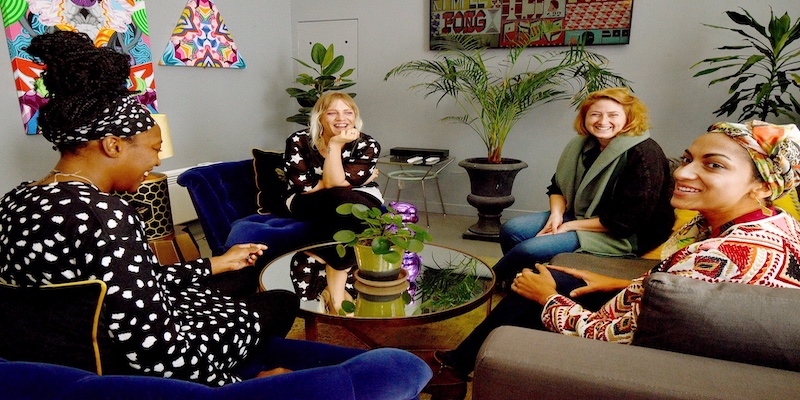Picture the scene. You’re standing at the water cooler when reality hits you. The matrix has become unplugged. The beige-tinted glasses slip right off your face and you’re confronted with row after row of sterile cubicles, lifeless PCs with generic screensavers — endless rows of mundanity.
Each row is like a wing of a prison. Except the people aren’t there to be rehabilitated, they are there to slowly have their creativity, their individuality, their uniqueness sucked away day after day.
There’s got to be a better way of working! However, in this brutal world of fluorescent lighting, suspended ceilings with more holes than a block of Swiss cheese, and lifts crammed like sardines each and every morning, it can become hard to see the wood through the trees.
Fortunately though, there is hope in sight. The office of the future doesn’t need to be hyper focused on whether or not the contents of the vending machine has been updated, or if somebody has or has not microwaved fish for their lunch. The office of the future should be a kaleidoscope of colour, creativity, and collaboration — a carnival of coworking connection and camaraderie. This is everything we’ve cultivated here at Use.Space.
Changing Culture in the Workplace: Embracing the Shift
In the modern, post-pandemic era, a time where the line between work life and home life has been blurred beyond recognition, the idea of traditional office spaces is being gradually tossed aside like a snotty tissue. There is a changing culture in the workplace, and the decision-makers will need to adapt or face being left behind.
The cubicle farms of the past are giving way to a new breed of free-range office spaces. Spaces where workers are able to roam free amongst comfortable and inviting spaces, artisanal coffee machines, and all the creature-comforts you could need in a working environment.
In truth, unless you worked at Google, Pixar, or a trendy Silicon Valley startup, the concept of an office space has been kept virtually exactly the same for decades. It has been done one way, just because that’s how it’s always been done. Why fix something that ‘ain’t broke’?
Well, for many it clearly is ‘broke’. A survey conducted by U.S business Gensler found that employees with more control over their working environment are much more satisfied, engaged, and productive. The study made sure to emphasise the clear need for creative, flexible, and dynamic workspaces if companies want to maximise their workforce.
What Tomorrow’s Workplace Should Look Like
The office of tomorrow, whether that’s literally tomorrow, next year, or ten years down the line, should focus on the wants and needs of the people in them. Without happy workers, businesses won’t operate to the maximum of their potential. So to meet this growing demand, companies should look into what they can do to improve wellbeing and job satisfaction.
Quality of Life Features
The opportunity to improve the quality of life of the people in their team is something company directors and upper management should keep a close eye on in the future.
As mentioned above, the working from home era of the pandemic has had a significant impact on the way we now work. It can be seen as a watershed moment for shifting the aims and goals of our workforces. It led more and more people to realise that what they had come to expect from an office environment was no longer working for them.
Workers are not oranges. You can’t just put them into the machine and squeeze them until there’s no juice left and move onto the next one.

Employe retention has a significant impact on productivity, the customer experience, culture, ROI, company and expertise.
Ultimately, an employee is far more likely to stay with a firm they believe in — and one of the easiest ways to make a team believe is to come up with ways to help make and keep them happy. If they enjoy coming into work, you stand a much better chance to keep them onboard.
Things you can consider to improve your work environment include:
- Flexible working
- Wellness initiatives
- An inclusive environment
- Autonomy and trust
Wellbeing Considerations
A strong focus on the wellbeing of a team is vital if you want to help build a new company culture. If the people running the office of the future place a proper focus on the physical, emotional, and mental health of their team, they stand to benefit in a number of areas.
It promises to improve productivity, because healthier and more engaged employees are far more likely to deliver consistently high quality work. Additionally, fostering a supportive working environment will mitigate the dangers of burnout — one of the largest factors that can lead somebody to leaving a job.
The shift in recent years to prioritising well-being in the name of promoting a positive company culture, works wonders if you’re looking to attract and retain engaged professionals and fuel innovation wherever possible. In the years to come, if the current trend is able to continue, employees will feel more and more cared for. This in turn will make them more likely to actively engage in creative problem-solving and communicate more effectively.
This ideal approach to wellbeing in the workplace promises to not only improve the lives and work/home balance of employees, but also significantly improve your long-term performance.
Think About the World Around us
Our planet is struggling. After decades of neglect and abuse, we urgently need to change our ways. The future has to be green if we want to even begin to undo some of the damage we have caused to our environment.
As we stand today, at the cusp of an all new era of working, one thing should be abundantly clear — the office of the future has to seriously consider environmental consciousness and sustainability.
The days where office design focuses entirely on aesthetic and functionality are gone. Tomorrow’s workplace must harness innovative technologies and practices to minimise its carbon footprint and overall impact on the planet. Methods that can be implemented in an office to this end include:
- Energy efficient lighting
- Intelligent climate control systems
- Increased use of renewable materials
- Self-generating utilities (solar power, harvesting rainwater, etc.)
- Recycled or upcycled furnishings

With any number of these methods implemented, places of work don’t have to simply be buildings for people to tap away at a keyboard, they can be connected ecosystems designed to coexist with and complement the natural world.
Imagine a world where office spaces are focussed on sustainable practices. Where connection to the natural world is put on the same pedestal as connections among employees and with clients/consumers.
As we navigate a new existence, a world grappling with the threats and complexities that come with climate change, the office of the future must serve as a model of responsible stewardship, to inspire and encourage future generations. Tomorrow’s workplace has to manifest the collective resolve we all have to create a world where the planet and its people are no longer totally disparate but are instead seamlessly intertwined and pulling in the same direction.
Helping Everybody Grow Together
With the way the market is heading, the office of the future will connect people. While current agencies and stuffy office spaces will specialise in specific areas or industries, all signs point towards a significantly more flexible, free-flowing working culture going forwards.
Currently, the people making the decisions want to keep their cards close to their chest. They do this by keeping all of their firm’s ideas internally, never looking to share.
However, the future should be in connectivity. When people of various specialities come together to share ideas and expertise, then the entire collective is built up and is able to grow together. A community who pulls in the same direction can go further than an individual.
If you put a child in a room with some blocks and ask them to build a tower, they’ll likely only be able to construct something a few blocks up before it begins to wobble and fall. However, with a group working together towards the same goal, they will be able to construct something as tall as they are. There is no reason the office can’t be like this. Collaboration with like-minded individuals can be a new secret weapon for businesses looking for an edge.
A Glimpse Into the Office of the Future, Today
When thinking about the office of the future, oversaturation of science fiction tropes may lead to you to thinking of any number of the following:
- Sterile, white-walled environment
- Metallic surfaces
- Minimalist design
- Pastel uniforms
- Significant integration of artificial intelligence
- Hologram monitors
- Robotic assistants

However, as you spend more and more time in a coworking space, surrounded by t-shirts and shorts instead of suits and ties, trading chats about stocks with being surrounded by colourful socks, sipping a vanilla latte you made with your own bare hands, watching while all around you creative thoughts are allowed to grow and expand, it can be easy to wonder — Is the office of the future right in front of me, and I just missed the email?
This ideal office of the future should represent whatever the workforce of the day wants it to. If the ideal situation is to balance work life with wellness then so be it. Tomorrow’s office space should represent whatever the people in it want it to. It should reflect the liberation of the creativity that the world’s workforce has been forced to hide for so long.
At Use.Space, we are passionate about creating a space and a template that we feel can be built on in the year to come. Our dream is for the spaces behind our doors to stand out as the ideal office of the future, today.
We want it to be a cocktail of liberation and professionalism, all under one roof. The chains of tradition have been shattered and discarded, and in their place stands an opportunity to connect and pursue success your way.
Are you looking for a taste of the office of the future today? Get in touch today to find out more and join our community.
